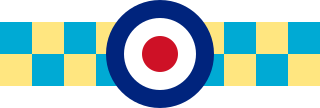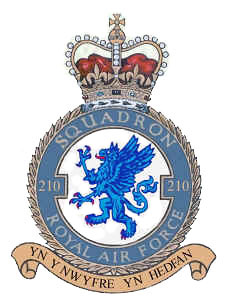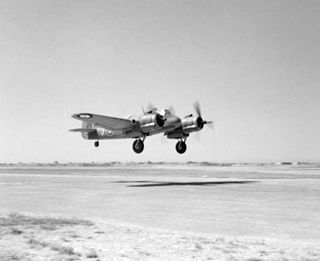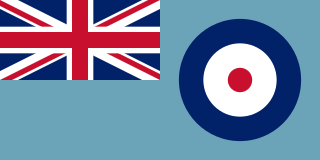
No. 206 Squadron is a Test and Evaluation Squadron of the Royal Air Force. Until 2005 it was employed in the maritime patrol role with the Nimrod MR.2 at RAF Kinloss, Moray. It was announced in December 2004 that 206 Squadron would disband on 1 April 2005, with half of its crews being redistributed to Nos. 120 and 201 Squadrons, also stationed at Kinloss. This was a part of the UK Defence Review called Delivering Security in a Changing World; the Nimrod MR.2 fleet was reduced in number from 21 to 16 as a consequence.
No. 119 Squadron RAF was a squadron of the Royal Air Force (RAF), flying with Coastal Command during the Second World War. It was the only RAF unit flying the Short G class and Short C class flying boats.

No. 461 Squadron was a Royal Australian Air Force maritime patrol squadron during World War II which operated under Royal Air Force control flying in Europe and over the Atlantic. The squadron was formed in 1942 and was disbanded in mid-1945, just after the end of the war in Europe. Personnel were drawn from many countries of the British Empire, although the majority were Australians. Throughout the war, the squadron was credited with destroying a total of six German U-boats, and operated mainly in the Bay of Biscay and Atlantic.

No. 245 Squadron was a squadron of the Royal Air Force. It flew as an anti-submarine squadron during World War I and as a fighter squadron during World War II. After the war it was first a jet-fighter squadron and its last role was as a radar-calibration unit.
No. 246 Squadron RAF was a squadron of the Royal Air Force.

No. 205 Squadron was a Royal Air Force unit formed on 1 April 1918. Prior to this it had existed as No. 5 Squadron of the Royal Naval Air Service (RNAS). In 1929, it became the first RAF squadron to be permanently based in Singapore, taking as its motto Pertama di Malaya. No. 205 Squadron operated during the Second World War and the Cold War before disbanding on 31 October 1971.

No. 210 Squadron was a Royal Air Force unit established in the First World War. Disbanded and reformed a number of times in the ensuing years, it operated as a fighter squadron during the First World War and as a maritime patrol squadron during the Spanish Civil War, the Second World War and the Cold War before it was last deactivated in 1971.
No. 228 Squadron RAF was a squadron of the Royal Air Force active at various times between 1918 and 1964. It spent the greatest part of its existence flying over water, doing so in the First, and Second World Wars and beyond, performing anti-submarine, reconnaissance and air-sea rescue tasks.

No. 235 Squadron RAF was an anti-submarine warfare squadron of the Royal Air Force which disbanded during July 1945. It was active in both the First World War, forming during August 1918 and disbanding in February 1919, and in the Second World War, reforming at the end of October 1939, and served as a squadron in RAF Coastal Command.
No. 204 Squadron was a Royal Air Force unit first formed in March 1915 as No.4 Squadron Royal Naval Air Service.
No. 274 Squadron RAF existed briefly in 1918 and 1919 as a patrol and bomber squadron, and served in World War II as a fighter squadron.

Number 209 Squadron of the British Royal Air Force was originally formed from a nucleus of "Naval Eight" on 1 February 1917 at Saint-Pol-sur-Mer, France, as No. 9 Squadron Royal Naval Air Service (RNAS) and saw active service in both World Wars, the Korean War and in Malaya. The use of the squadron number ceased in 1968 and it has not been reused since by an RAF squadron. The number, badge and motto is in service within the RAF Air Cadets at 209 Squadron ATC in Nottinghamshire.
No. 292 Squadron RAF was an air-sea rescue (ASR) squadron of the Royal Air Force operating in the Bay of Bengal during the Second World War.

No. 1451 (Fighter) Flight was formed at RAF Hunsdon, Hertfordshire on 22 May 1941, equipped with Turbinlite Douglas Boston and Douglas Havoc aircraft. On operations they co-operated at first with Hawker Hurricanes of No. 1422 Flight RAF and later with Hurricanes of 3 Squadron. The flight was replaced with 530 Squadron on 8 September 1942 but officially disbanded as late as 25 January 1943.

No. 1456 (Fighter) Flight was formed at RAF Honiley, Warwickshire on 24 November 1941, equipped with Turbinlite Douglas Boston and Douglas Havoc aircraft. On operations they cooperated with the Hawker Hurricanes of 257 Squadron. The flight was replaced with 535 Squadron on 2 September 1942 but officially disbanded as late as 25 January 1943.

No. 1460 (Fighter) Flight was formed at RAF Acklington on 15 December 1941, equipped with Turbinlite Douglas Boston and Douglas Havoc aircraft. The flight became operational in May 1942 and made its first and only contact with the enemy in June of that year. On operations they cooperated first with the Hawker Hurricanes of 43 Squadron and later with those of 1 Squadron. The flight was replaced with 539 Squadron on 2 September 1942 but officially disbanded as late as 23 January 1943.
No. 240 Squadron RAF was a Royal Air Force flying boat and seaplane squadron during World War I, World War II and up to 1959. It was then reformed as a strategic missile squadron, serving thus till 1963.

No 279 Squadron RAF was a Royal Air Force air-sea rescue squadron of World War II. The squadron was formed on 16 November 1941 and disbanded on 10 March 1946.
No. 244 Squadron RAF was a Royal Air Force Squadron formed as an anti–submarine unit in World War I and a bomber and anti-submarine unit in the Middle East in World War II.

RAF Iceland is a former Royal Air Force command which controlled RAF units within Iceland. The command was operational between July 1941 and July 1945 during the Second World War, the unit was previously No. 30 Wing RAF.











